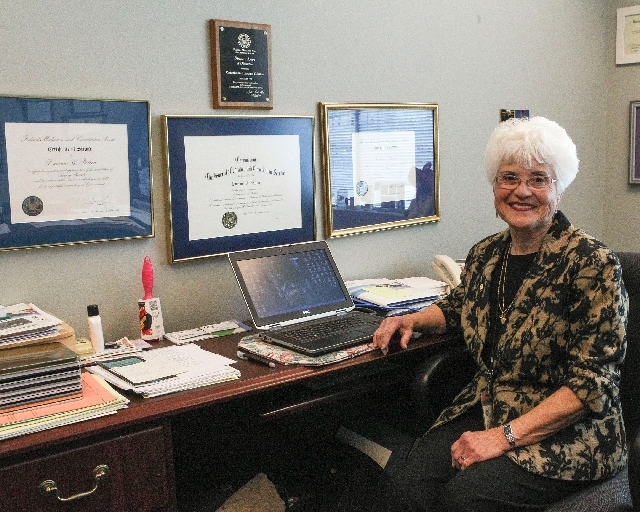Nevadan at Work: Mediator works for labor-management harmony
Locked in contract negotiations more than three decades ago, Lavonne C. Ritter found her career inspiration in someone both labor and management had tagged with a seemingly unflattering sobriquet: “Big Foot.”
A federal labor mediator, “Big Foot” earned the name because at strategic junctures, “he put his foot in both of our behinds and made us move,” Ritter recalls with admiration. Uncomfortable as it may have been at times, she credits “Big Foot” with moving the two sides toward a resolution.
This workmanship led Ritter to point her future toward becoming a mediator. She had worked on the management side of the table, but then took union jobs so she could gain a broader perspective.
That ultimately led, nearly a quarter century ago, to a career as a commissioner with the Federal Mediation & Conciliation Service. Now 73, and on call around the clock, Ritter says retirement is still not in sight.
“I think I died and went to heaven when I went to work for the federal mediation service because the (management and labor) advocates do the hard part. We just have to help them do the hard part,” she says.
Ritter says, a mediator’s role is simple: “It may look like the two sides are a Grand Canyon apart. What you want to do is get it down to the Colorado River so they can forge it together. That’s our responsibility. The Colorado is not an easy one to forge, but 95 percent of the time the parties get there.”
To pull it off, mediators reach into a deep bag of techniques to push, pull, prod and massage two sides together, sometimes when the emotional temperature reaches August-like levels. All the while, mediators take care to maintain strict neutrality.
The mediation service, with three commissioners in Las Vegas, keeps a low profile by design; the service never comments on cases — past, present or potential.
But both sides in the recent two-month drivers’ strike against the Yellow Checker Star Transportation cab company acknowledged the patient work of a mediator in bridging entrenched positions.
According to the agency’s annual report for fiscal 2012, it mediated 4,528 cases nationwide and assisted in settling 84 percent of them.
The agency also participated, without charge, in several thousand more grievance and employment mediations, training programs and meetings with groups and companies, including two landmark pacts in which Ritter played a role concerning labor relations on the Strip and at the Nevada National Security Site, formerly called the Nevada Test Site.
Question: You’re a mediator, not an arbitrator. What’s the difference?
Answer: Unlike arbitrators, I make no final and binding decisions. First of all, I must be acceptable to the parties as a third-party neutral, which means I am not biased toward labor or management. Our job is to assist in finding common ground to fashion an agreement on their own.
Hopefully, we are equipped with sufficient expertise in the collective bargaining process in various industries, the public, federal and private sectors. The only real power we have is the power of persuasion and the parties acceptance of our role and the level of expertise that we can provide.
Question: What aspects of the service are not well understood by outsiders?
Answer: People think we report to some other government agency. In fact, we are an independent agency of the federal government, and our executive director reports to the executive branch. We are not regulatory; we are not enforcement. Many people confuse us the National Labor Relations Board, which is a regulatory and enforcement agency.
Question: How do you pick the techniques to smooth the process?
Answer: It’s mediator intuition and experience. Its knowledge of the parties, awareness of principles that may be driving them jointly and/or separately, history and the economic environment. We spend time getting acquainted with the individual members of their committees.
We’re very aware of body language. We’re very careful to make a correct assessment of what that means. We are careful to try to understand underlying or unspoken reasons for why the parties are where they are. We have to develop positive interactions with both parties and their teams.
Question; You carry messages back and forth between two sides. Does that include ones with four-letter words?
Answer: No, not usually. You will see a sign posted in our conference room that says no retromingency, and it’s something we talk about with the parties.
A retromingent is an animal that urinates backwards.
To the parties involved, it means that we are not going to piss backwards on each other. We make an agreement, and our word is good and our signature is good.
Question: Can a mediator get too involved?
Answer: A mediator cannot want the settlement more than the parties do. That’s a hard thing for young mediators to learn, and it’s still difficult because we want to see the parties settle. We have to get the parties to want to settle and to fashion their settlement.
Question: When you engage in marathon bargaining sessions, what keeps you going?
Answer: Most mediators probably drink a lot of coffee or caffeine-laden soda, but some just have a great energy level. At my age, you might think, Jiminy Christmas, that old girl gets pretty tired. And I might, if it weren’t for the fact that the parties are so energizing to me. Even at 73, it doesn’t bother me to work all night as long as I can get some sleep the next day.
Question: You credited Big Foot as being a career inspiration. Has anybody referred to you as Big Foot?
Answer: I don’t know. But he was great. That was when I decided what I wanted to be when I grew up.
Question: Would the Big Foot label have ever applied to you?
Answer: Might have.
Contact reporter Tim O’Reiley at
toreiley@reviewjournal.com or 702-387-5290.
VITAL STATISTICS
Name: Lavonne C. Ritter.
Age: 73
Position: Commissioner, Federal Mediation & Conciliation Service.
Family: Two children, three grandchildren and one great- granddaughter.
Education: Boulder City High School, 1957; associate’s degree, Colorado Women’s College, 1959; bachelor’s degree in human relations and organizational behavior, University of San Francisco, 1981, earned while a working mom.
Work history: Nearly 30 years split between working for the private sector and organized labor. Had personnel, security and labor relations duties on management side; public sector advocate for a union; first position came in late 1959 at the Nevada nuclear test site, then called the Lawrence Radiation Laboratory; joined the mediation service in 1988.
Hobbies: Classical music; scratch golfer ("I hit it short but straight."); spending time with her great-granddaughter.
Favorite book: The George R.R. Martin books that form the basis for the TV series "Game of Thrones." Also books by China Mieville.
Hometown: Salina, Kan.
In Las Vegas since: 1996.
Quotable: "At my age, you might think, Jiminy Christmas, that old girl gets pretty tired. And I might, if it weren’t for the fact that the parties are so energizing to me."
The Federal Conciliation and Mediation Services is at 110 City Parkway, Suite 300,
Las Vegas, NV 89106. It can be reached at 702-363-5857.

















